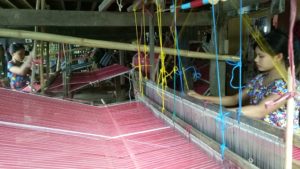Traditional weaving businesses in Mudon Township struggling to survive
September 14, 2017
 HURFOM: Traditional weaving businesses in Mudon Township are struggling to survive due to declining profitability with the influx of modern weaving technology.
HURFOM: Traditional weaving businesses in Mudon Township are struggling to survive due to declining profitability with the influx of modern weaving technology.
“Nowadays, traditional weaving businesses cannot compete with modern weaving machines, so they will gradually disappear. We are stuck with this job because we can’t do other work and don’t have enough money to invest in another business. Even if it isn’t profitable enough, this is all we can do [for our livelihoods]. After paying wages to workers, only enough for our meals is left for us. It’s impossible to do traditional weaving as a long-term business. The world is changing everyday,” said a weaver from Kyaik Roi.
Traditional weaving was once a popular profession in Kyaik Roi, Ta Gon Tyle, Nyne Hlone, Kamarwat, and other villages in Mudon Township. However, traditional weavers have faced a huge challenge with the creation of modern weaving machinery.
“It doesn’t create enough profit. We have to pay nearly 4,000 kyat (US $2.94) to a single worker per day. A traditional weaving machine leaves only 1,000 kyat (US $0.75) [profit] to us per day. If you have 10 weaving machines, you can earn 10,000 [kyat] (US $7.35) and if you have 20 machines, you can have 20,000 [kyat] (US $14.69). I have only five machines so I can earn between 5,000 (US $3.67) to 10,000 kyat per day. [Sometimes], I can only earn the same amount as a daily worker. I don’t have another job so I have to continue what I’m doing. But it will be difficult in the future,” said Mi Cho, an owner of traditional weaving machines.
Most traditional weavers produce ethnic Mon and Karen clothing, bags, and scarfs, and the products are sold in Mudon and Mawlamyine in Mon State, as well as Hpa-an in Karen State.
Demand for traditional Mon and Karen clothing is at its highest prior to Mon and Karen national days, and traditional weaving businesses enjoy higher profits during these periods.
Clothes made by traditional weavers are thicker and more expensive than clothes made by modern weaving machines. However, customers who prefer hand-made clothes have been buying clothes made by traditional weavers.
“Now traditional weaving can’t compete with modern weaving in the market. The owners of traditional weaving machines have a huge challenge to continue their business in the long-term,” said a local from Mudon.
Comments
Got something to say?
You must be logged in to post a comment.



















































